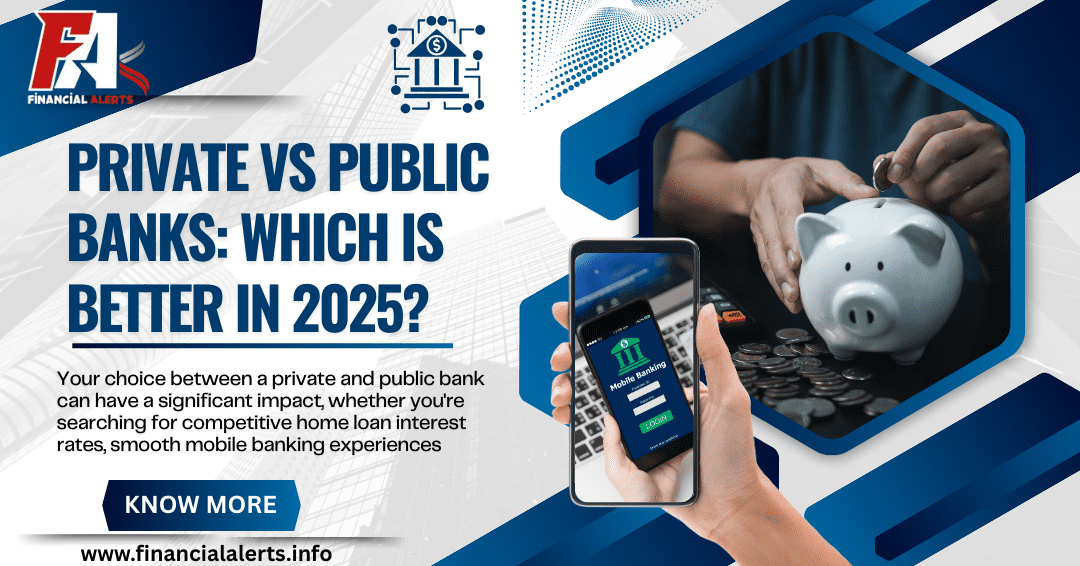It is more important than ever to choose the correct bank in India’s changing financial environment. Your choice between a private and public bank can have a significant impact, whether you’re searching for competitive home loan interest rates, smooth mobile banking experiences, or higher fixed deposit interest rates.
In order to help you in selecting the best option, we will look at important comparison between private and public banks in India in 2025. These comparisons will cover topics such as bank interest rates, FD returns, savings accounts, net banking services, and loan benefits.
What is a Private Bank and Public Bank?
A private bank is a type of financial institution that is owned by private companies or individuals and provides high interest rates, personalized customer service, and modern benefits like mobile banking.
A public bank, on the other hand, is run and owned by the government, providing safety, authority, and easier access to remote areas. SBI, Bank of Baroda, and PNB are a few examples. Savings accounts, fixed deposit interest rates, net banking, and home loan interest rates are among the services provided by both types; however, their customer service, digital access, and efficiency range.
1. Fixed Deposit Interest Rates: Who Offers Better Returns?
📌 Public Banks:
Public sector banks like SBI, Bank of Baroda, and Punjab National Bank typically offer FD interest rates between 6% to 7.10% for general citizens, with an additional 0.50% for senior citizens. The rates are relatively stable but conservative, designed for low-risk investors.
📌 Private Banks:
Private banks like HDFC, ICICI, and Axis Bank often offer slightly higher Fixed Deposit Rates, sometimes up to 7.5% or more for selected tenures. Some small finance and new-age private banks even cross the 8% mark, targeting aggressive savers and high-net-worth individuals.
✅ Verdict: Private banks generally lead in FD interest returns, but public banks provide more stability and trust, especially for risk-averse investors.
2. Bank Interest Rates on Savings Accounts
📌 Public Banks:
Most government banks provide savings account interest between 2.70% to 3.50% annually. They offer fewer benefits on standard accounts but prioritize safety and long-term relationship benefits like pension processing or government scheme linkage.
📌 Private Banks:
Private banks are aggressive here. They offer interest rates between 3.5% to 6% on savings accounts, especially for balances above ₹1 lakh. Some digital-only accounts provide higher interest as part of promotional schemes.
✅ Verdict: Private banks offer better bank interest rates on savings accounts along with add-ons like debit card offers, cashbacks, and reward points.
3. Home Loan Interest Rates in 2025
📌 Public Banks:
In 2025, public banks continue to dominate this segment. Home loan interest rates in public sector banks like SBI range between 8.3% to 9.15% depending on credit score and loan amount. They are known for transparent charges and minimal processing fees.
📌 Private Banks:
Private players provide home loans starting from 8.5%, but rates can go higher based on risk assessment. While they process applications faster and offer doorstep services, hidden charges and fluctuating rates are common concerns.
✅ Verdict: Go with public banks for long-term housing loans if you want lower and transparent interest rates; opt for private banks if faster processing and premium services matter more to you.
4. Mobile Banking & Net Banking Experience
📌 Public Banks:
Government banks have upgraded their digital platforms significantly in 2025. SBI’s YONO app and similar platforms now offer improved UI, bill payments, investments, and loan tracking. However, occasional downtimes and slower UI remain common complaints.
📌 Private Banks:
Private banks are clear winners in the digital space. Mobile banking apps from HDFC, ICICI, and Kotak offer robust features—instant fund transfers, wealth management, credit card integration, AI chat support, and even investment advice.
Net banking interfaces of private banks are sleek, fast, and customer-friendly, with advanced security features like face ID, voice commands, and biometric authentication.
✅ Verdict: Private banks offer a superior digital experience across both mobile banking and net banking.
5. Loan Processing and Approval Time
📌 Public Banks:
Public banks are known for their due diligence but often have longer approval times due to documentation and compliance checks. They are ideal for salaried individuals and government employees who meet standard eligibility.
📌 Private Banks:
Private banks have faster loan disbursal systems, with some even offering pre-approved personal loans via apps. However, they may charge higher processing fees and interest for unsecured loans.
✅ Verdict: Choose private banks for quick loans, and public banks for secure, low-cost long-term loans.
6. Customer Service & Branch Reach
📌 Public Banks:
Public banks have a wider rural presence and larger ATM and branch networks, especially in tier 2 and tier 3 cities. However, customer service at branches is often slow, and queues are still common.
📌 Private Banks:
Private banks offer priority banking services, video KYC, and dedicated relationship managers for high-value clients. But rural reach is still limited, and many services are urban-focused.
✅ Verdict: Public banks have better physical reach, while private banks deliver better customer experience, especially online.
Conclusion: Which Is Better for You in 2025?
| Feature | Public Banks | Private Banks |
| FD Interest Rates | Moderate | Slightly Higher |
| Savings Account Interest | Low | High |
| Home Loan Rates | Low & Transparent | Quick but Costlier |
| Mobile & Net Banking | Improving | Advanced |
| Loan Processing Speed | Slower | Faster |
| Branch Reach | Rural Dominance | Urban Dominance |
| Customer Service | Traditional | Personalized |
| Trust Factor | High | Moderate |
✅ Best for Risk-Free & Long-Term Banking: Public Banks
✅ Best for Digital, Fast, and Rewarding Banking: Private Banks
✍️ Final Tip:
If you’re a tech-savvy urban user looking for premium services, private banks offer great value in 2025. But if you want long-term stability, government linkage benefits, or plan to take a home loan, public banks offer unmatched trust and value.

India’s Finance and Banking Sector latest news on financialalerts.in . Also, get the Banking, Finance, and Investment Tips. Get the Stock market Updates.


